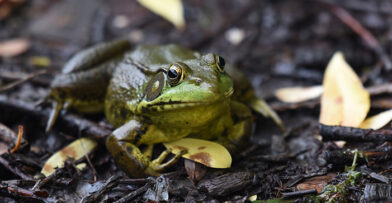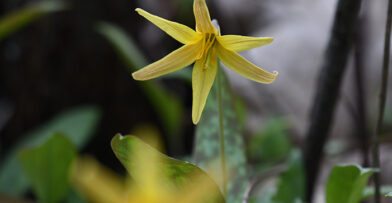The winter landscape provides new experiences for our senses. Though there aren’t freshly bloomed flowers to smell, or brightly colored leaves to see during this season, what is available to our senses is just as refreshing.
Once you’re dressed in layers and ready to explore the trails, you will appreciate the benefit of being an endothermic creature that is able to generate your own body heat. It’s with this adaptation that you can enjoy the outdoors in all types of weather. As you feel the warmth contained within your winter gear, you can easily tell where there may be gaps as a cold wind rushes through. As the brisk wind meets your cheeks, take note of how the mammals of Wisconsin survive at this temperature, mainly by being entirely covered in fur.
Other animals that stay in Wisconsin year-round have different methods of staying warm. Black-capped Chickadees fluff up their feathers during the cold days of winter, creating an extra layer of insulation. Listen throughout the forest and near the bird feeders for their iconic call, either saying their name or singing, “Hey Sweetie.” Other winter resident birds that you are able to hear along the trails include the Pine Siskin, with a zipper-like call, the barking of the Red-bellied Woodpecker, and the Great Horned Owl, with their classic hoot.
Many of these birds can stay here because their diet consists of seeds, such as those found among the seed heads in the prairie along the Gateway Trail. Though you won’t be consuming these seeds, you can still indulge in their lingering fragrance. If you find mountain mint and wild bergamot, give the seed heads a gentle squish between your fingers to catch a whiff of their once potent scent. From the prairie, you can meander to the forest to find the coniferous trees, which have their own distinctive smell. To enjoy the aroma that might remind most of the holiday season, look for sap that has oozed out of the bark and frozen in place with the cold. Though the sap has become more solid than during the warmer season, avoid sticky fingers by using a small branch you find on the ground to pierce the sap and savor the coniferous fragrance.
Another memorable occurrence that takes place during this season is the beginning of a snowfall. Depending on the temperature and the humidity level of the air, you can see a variety of snowflake shapes. The timeless shape of a snowflake can be observed up close, especially if you are wearing dark colored winter gear. If your gear isn’t conducive to seeing the patterns, consider carrying a piece of black felt. On this fabric, you can identify snowflakes shaped like plates, dendrites, and needles.
After your hike, you can treat yourself to a complimentary warm beverage inside our Visitor Center. Once settled, reflect on the memories created along the trails in winter by utilizing all of your senses.


